Cameras, a must-have tool for capturing life’s precious moments, often come with a hefty price tag. But have you ever wondered why cameras are so expensive? In this article, we’ll delve into the factors that contribute to the high price points of cameras and shed light on the mystery behind their cost.
From advanced technology and top-notch materials to extensive research and development, various elements play a role in the pricing of cameras. Understanding these factors can help you appreciate the value that cameras bring to your photography journey and make informed purchasing decisions.
Key Takeaways:
- Cameras are expensive due to factors like advanced technology and features, high-quality materials, and extensive research and development efforts.
- Understanding memory card performance indicators like throughput and capability is crucial for optimal camera performance.
- Camera lenses contribute significantly to the overall cost of cameras, with precision engineering and premium materials playing a key role.
- Durability, reliability, and robustness are important considerations in camera equipment pricing.
- Backward compatibility and brand reputation contribute to the higher prices of certain camera lenses.
Understanding Memory Card Costs and Performance
When it comes to memory cards, photographers often find themselves puzzled by the wide range of prices and confused about which card will deliver the best performance. To unravel this mystery, it’s essential to understand the factors that contribute to memory card costs and their impact on performance.
The cost of a memory card is influenced by several factors, including its throughput and capability. These factors are indicated by numeric values such as X, UHS classifications, and UDMA ratings. While these numbers may seem technical, they essentially represent the card’s maximum data transfer rate in megabytes per second. It’s important to note that the camera’s internal bus performance also plays a role in determining the actual data transfer speed.
Choosing the right memory card with the appropriate throughput is crucial for achieving optimal performance. For professional photographers capturing high-resolution images or shooting rapid bursts of photos, a memory card with a higher throughput is recommended. On the other hand, hobbyists or casual photographers may find that a card with a lower throughput suits their needs just fine.
Ultimately, finding the right balance between price and performance is key. While it can be tempting to simply go for the most expensive memory card available, it’s important to consider your specific photography needs and budget. By understanding the numeric values associated with memory cards and their relationship to performance, photographers can make informed decisions and maximize their shooting experience.
The Intricate Engineering of Camera Lenses
Camera lenses are the unsung heroes behind every stunning photograph. With their intricate engineering and meticulous design, they play a crucial role in determining the image quality and overall performance of a camera. Understanding the complexities of camera lenses can shed light on why they contribute significantly to the higher price tag of cameras.
The engineering process involved in creating camera lenses is a delicate balance of art and science. Precision-ground glass elements are carefully crafted to minimize distortion and aberrations, ensuring optimal image quality. Specialized coatings, such as anti-reflective coatings, are applied to minimize lens flaws and enhance light transmission, resulting in improved clarity and contrast.
Camera lenses also utilize premium materials to deliver exceptional performance. High-quality lens glass, often in the form of fluorite or extra-low dispersion glass, is used to minimize chromatic aberrations and produce sharp, accurate images. The use of advanced materials, such as magnesium alloy or carbon fiber, not only makes lenses lighter but also enhances their durability and robustness.
“Camera lenses are a testament to the pursuit of optical perfection. Their intricate engineering and premium materials result in image quality that can capture every detail, every color, and every emotion. It’s this commitment to excellence that justifies their higher price compared to other camera components.” – Professional Photographer
It’s essential to recognize that the constant research and development efforts to push the boundaries of optical performance further contribute to the cost of camera lenses. Manufacturers are continuously striving to improve lens designs, introduce new technologies, and perfect the art of lens production. This commitment to innovation ensures that photographers have access to the best tools for capturing breathtaking images.
Durability and Reliability of Camera Equipment
When investing in camera equipment, photographers prioritize durability and reliability to ensure their gear can withstand the demands of their craft. Camera bodies and lenses need to be robust enough to handle various shooting conditions, including extreme temperatures, moisture, and physical impacts. Companies that produce camera equipment understand the importance of durability and invest in high-quality materials to create products that stand the test of time.
Camera bodies, in particular, are designed with reinforced polycarbonates and metal alloys to provide strength and durability. These materials not only protect the internal components of the camera but also ensure that it can withstand rough handling and challenging environments. Additionally, manufacturers incorporate weather sealing to prevent moisture and dust from entering the camera body, further enhancing its reliability.
Lenses, being one of the most essential components of a camera system, also undergo rigorous engineering to ensure they can deliver consistent performance. Lens barrels are typically made from durable materials like metal, providing stability and resistance to wear and tear. Moreover, lens elements are coated with specialized coatings to minimize lens flaws and maximize image quality.
Ruggedness Testing: Ensuring Reliability
Camera equipment manufacturers subject their products to rigorous testing to ensure durability and reliability. Ruggedness testing involves exposing the gear to extreme environments, such as freezing temperatures, high humidity, and vibrations. These tests simulate real-world scenarios to assess how well the equipment holds up under demanding conditions.
Ruggedness testing is crucial in determining the robustness of camera equipment. It helps manufacturers identify any potential weaknesses and make necessary improvements to enhance the durability and reliability of their products.
By prioritizing durability and reliability, photographers can have peace of mind knowing that their camera equipment can handle the challenges they may encounter during their photography journeys. Whether shooting in harsh weather conditions or in fast-paced situations, having gear that is built to last ensures that photographers can focus on their craft without worrying about equipment failures.
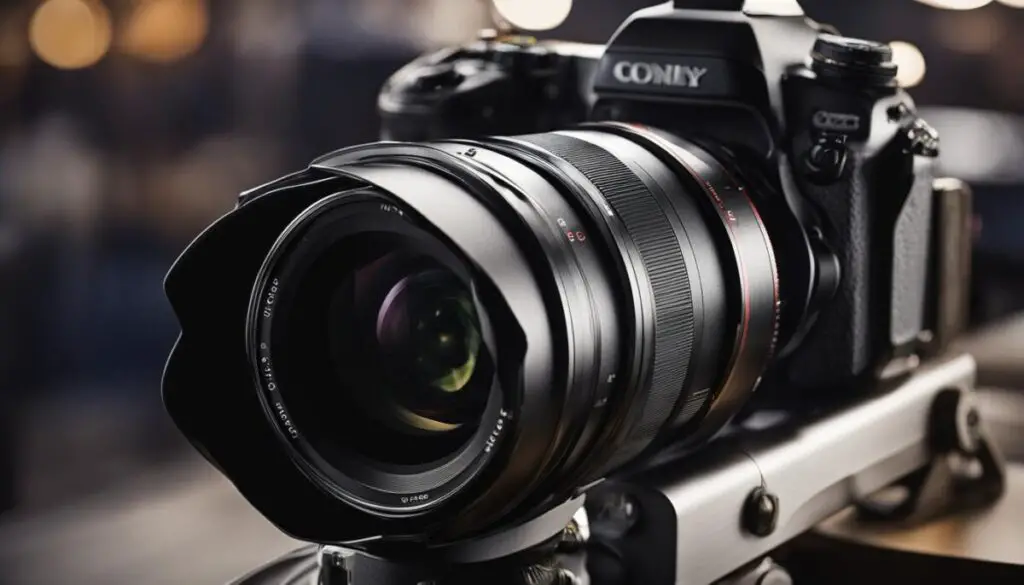
Backward Compatibility and Brand Reputation
When it comes to camera lenses, there are various factors that contribute to their higher price points. One such factor is backward compatibility. Reputable brands like Nikon have a long-standing tradition of ensuring that lenses produced decades ago can still be used on their latest camera bodies. This commitment to backward compatibility requires meticulous design and engineering efforts, resulting in lenses that offer versatility and convenience to photographers.
In addition to backward compatibility, brand reputation also plays a significant role in the pricing of camera lenses. Brands like Nikon have established themselves as leaders in the industry, known for their commitment to quality, innovation, and customer satisfaction. The brand value and reputation contribute to the perceived value of Nikon lenses, leading to higher price points.
Investing in high-quality camera lenses, such as those from Nikon, not only ensures compatibility across multiple camera bodies but also offers superior optical performance and durability. Photographers can trust in the brand’s reputation and heritage, knowing that they are investing in lenses that will deliver exceptional image quality and withstand the demands of professional use.
Key Takeaways:
- Backward compatibility allows lenses produced decades ago to be used on the latest camera bodies, providing versatility and convenience.
- Brand reputation, such as Nikon’s long-standing commitment to quality and innovation, contributes to the perceived value of camera lenses.
- Investing in high-quality lenses offers superior optical performance, durability, and compatibility across multiple camera bodies.
NFL Photographers: Salaries and Freelance Rates
Being an NFL photographer is a dream job for many photography enthusiasts. It offers the opportunity to capture the thrilling moments of professional football games, but how much do NFL photographers make? The salaries for NFL photographers can vary widely depending on factors such as experience, reputation, and the specific team or organization they work for.
Freelance NFL photographers have the flexibility to set their rates, which can either be a flat rate per event or an hourly rate. These rates usually reflect their level of expertise, equipment, and the value they bring to the table. It’s not uncommon for experienced and well-known NFL photographers to command higher rates due to their established reputation and exceptional skill set.
In addition to their salaries or freelance rates, NFL photographers may also receive benefits such as health insurance, retirement plans, and paid vacation time. These perks contribute to the overall compensation package and provide financial security and stability for photographers in the industry.
NFL Photography Equipment: Capturing the Game in High Definition
When it comes to NFL photography, having the right equipment is essential for capturing the energy, excitement, and essence of the game. From camera bodies to lenses and accessories, every piece of gear plays a crucial role in delivering high-quality images that showcase the action on the field. Let’s explore the key components of NFL photography equipment and how they contribute to the overall success of capturing stunning football moments.
Camera Bodies:
The centerpiece of any NFL photographer’s arsenal is a professional-grade camera body. These bodies are designed to handle the fast-paced nature of the game, with features like high-speed continuous shooting, fast autofocus systems, and robust build quality. They provide the speed, accuracy, and durability required to capture split-second moments with precision. With options from renowned brands like Nikon and Canon, photographers can choose bodies that meet their specific needs and preferences.
Lenses:
Alongside camera bodies, lenses are paramount in NFL photography. Telephoto lenses with long focal lengths allow photographers to get up close and personal with the action on the field, capturing details and expressions that might otherwise be missed. The versatility of zoom lenses enables photographers to adjust their framing quickly, while prime lenses offer exceptional image quality and wide apertures for a shallow depth of field. From capturing the intensity of tackles to the elation of touchdowns, lenses are instrumental in bringing the game to life through the lens.
Accessories:
To enhance the performance of camera bodies and lenses, NFL photographers often utilize a range of accessories. These include tripod stands for stability during long exposures or extended shooting sessions, external flashes for additional lighting control, and filters to enhance color and reduce glare. Other accessories like memory cards with high write speeds and ample storage capacity ensure photographers can capture the fast-paced action without interruption. The right combination of accessories helps optimize the workflow and enables photographers to focus on capturing the perfect shot.
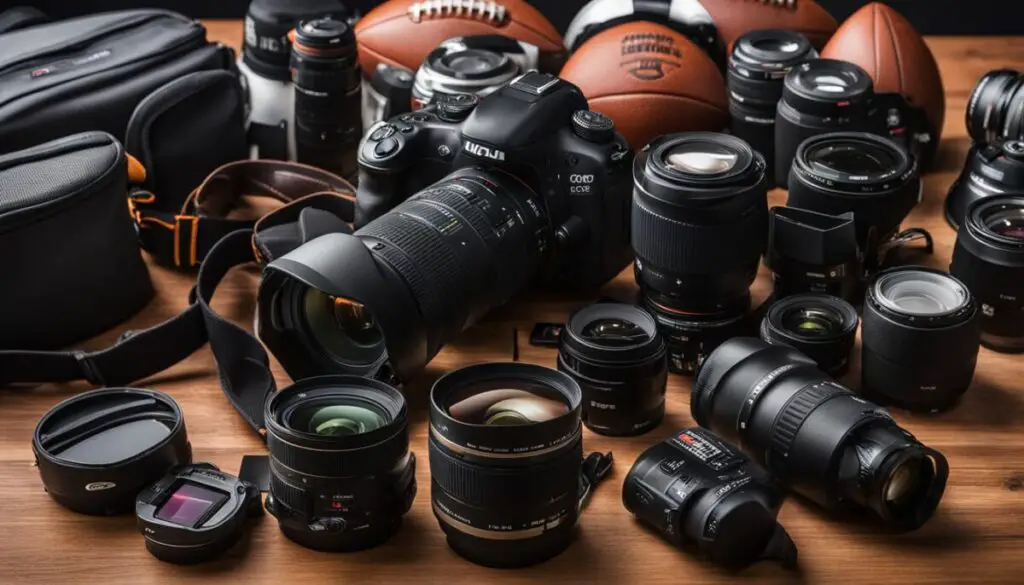
Investing in top-quality NFL photography equipment is crucial for photographers looking to capture the game in high definition. With advanced camera bodies, versatile lenses, and essential accessories, photographers can showcase their skills and immortalize the exhilarating moments that make football such a captivating sport. The right gear empowers photographers to freeze the action, evoke emotions, and contribute to the visual narrative of the game.
Becoming an NFL Photographer: Criteria and Requirements
Are you passionate about photography and football? Becoming an NFL photographer is an exciting career choice that allows you to combine your love for both. However, breaking into this field requires dedication, skill, and meeting certain criteria and requirements. Let’s dive into what it takes to become an NFL photographer.
1. Camera Equipment:
As an NFL photographer, you’ll need professional-grade camera equipment to capture the fast-paced action on the field. Investing in high-quality cameras, telephoto lenses, and accessories is essential to produce stunning images that tell the story of the game.
2. Portfolio:
Building a strong portfolio showcasing your sports photography skills is crucial to demonstrate your capabilities to potential employers. Include a variety of action shots, capturing the intensity, emotion, and energy of football games. Showcasing your unique style and ability to capture decisive moments will set you apart from the competition.
3. Networking:
Establishing connections within the football industry is key to landing opportunities as an NFL photographer. Attend local games, reach out to sports publications, and network with other professionals in the field. Building relationships can lead to freelance gigs, internships, or even full-time positions with NFL teams or media outlets.
Multifaceted Experience in Sports Photography
In order to excel as an NFL photographer, a multifaceted experience in sports photography is essential. It goes beyond simply capturing images; it requires a deep understanding of the game, the players, and the industry. The ability to anticipate the action and capture compelling moments that showcase the excitement and intensity of football is crucial.
Sports photography is a dynamic field that demands technical skill, creativity, and adaptability. To capture football action photos that truly stand out, photographers need to master their equipment and techniques. They must be able to navigate challenging lighting conditions, freeze fast-paced movements, and compose shots that tell a story. It’s a blend of technical proficiency and artistic vision that sets apart the best sports photographers.
The Three Keys to Success in NFL Photography:
- Technical Proficiency: A thorough understanding of camera settings, focusing techniques, and the use of telephoto lenses is essential in capturing crisp and sharp images.
- Artistic Vision: Being able to anticipate the action, find unique angles, and compose shots creatively can elevate sports photos from ordinary to extraordinary.
- Adaptability: NFL photographers must be ready to adapt to changing conditions and make split-second decisions to capture key moments during a game.
As an NFL photographer, you have the privilege of immortalizing the exhilarating moments that unfold on the football field. Each game presents a new challenge, and being able to capture the intensity and emotion of those moments is an art form in itself.
It takes time, practice, and a love for the game to excel in sports photography, particularly in the realm of NFL photography. The ability to anticipate and capture those split-second moments that define a game requires a unique set of skills and a passion for the sport. A multifaceted experience in sports photography sets the stage for photographers to capture the essence of football in a way that resonates with viewers.
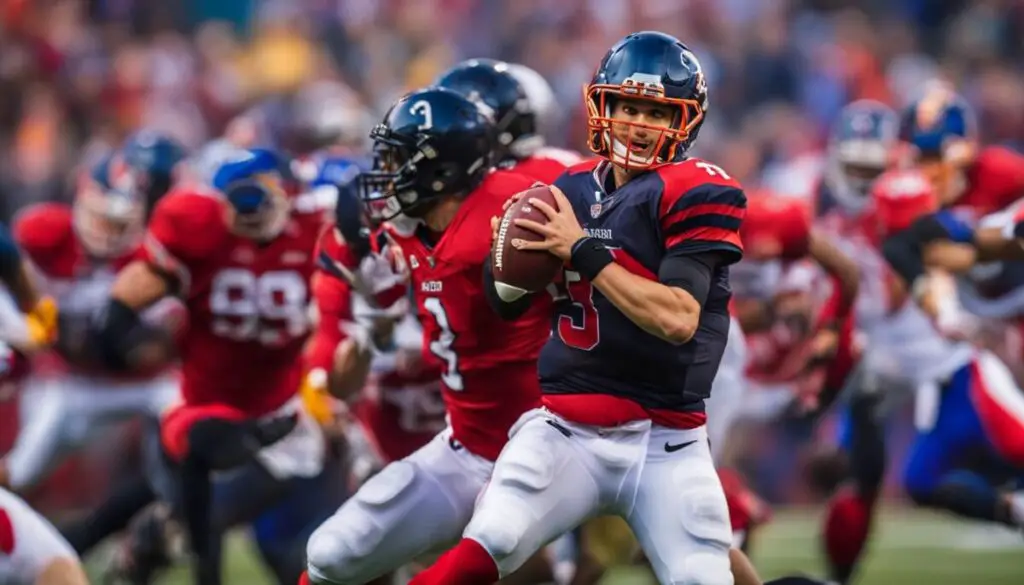
The Role of Technical Skill and Creativity in NFL Photography
When it comes to NFL photography, technical skill and creativity are essential ingredients for capturing breathtaking images that truly capture the essence of the game. A photographer’s technical skill encompasses their knowledge of camera settings, lighting techniques, and composition. By mastering these technical aspects, photographers can ensure that their images are sharp, well-exposed, and visually stunning.
In addition to technical skill, creativity plays a crucial role in NFL photography. Photographers must have the ability to think outside the box, anticipate the action on the field, and find unique angles and perspectives to capture captivating shots. Creativity allows photographers to tell a story through their images, conveying the emotions, intensity, and drama of the game to viewers.
A great NFL photographer is not just a technician but an artist, able to combine technical excellence with a creative eye. This combination allows them to capture images that not only freeze moments in time but also evoke emotions and transport viewers to the heart of the action. Whether it’s a player’s triumph, the intensity of a tackle, or the jubilation of victory, a skilled and creative NFL photographer can capture it all, creating visual narratives that resonate with fans and enthusiasts alike.
The Importance of Technical Skill
Technical skill is the foundation upon which creative photography is built. Understanding camera settings such as aperture, shutter speed, and ISO allows photographers to have full control over the exposure, depth of field, and motion blur in their images. This technical knowledge is crucial for capturing fast-paced NFL action, where split-second timing and precise focus are paramount. By having a strong grasp of technical aspects, photographers can ensure that their images are sharp, well-exposed, and properly convey the energy and intensity of the game.
The Power of Creativity
Creativity allows photographers to push the boundaries and go beyond capturing the obvious shots. It’s about finding and capturing unique moments, angles, and perspectives that tell a story and elicit an emotional response. Creative photographers have a keen eye for detail, spotting hidden gems and capturing fleeting moments that often go unnoticed. Whether it’s an incredible catch, a celebration, or the interaction between players, a creative NFL photographer can freeze these moments in time, creating images that leave a lasting impression.
The Average Salary of an NFL Photographer
The profession of an NFL photographer goes beyond capturing images on the field; it requires a comprehensive understanding of the game, the players, and the industry as a whole. The average salary of an NFL photographer typically falls around $75,000 per year. However, it’s important to note that this figure can vary based on factors such as experience level and the specific team or organization the photographer works for.
Being an NFL photographer is a demanding and specialized profession that requires a unique set of skills, expertise, and responsibilities. The salary reflects the value placed on their ability to capture the intensity, emotion, and story of football through their photographs.
Photographing NFL games requires high-quality equipment and the ability to work in fast-paced and challenging environments. NFL photographers must invest in professional-grade camera bodies, telephoto lenses, and other essential accessories to consistently produce top-notch images that meet the industry’s standards.
While the salary of an NFL photographer may seem high, it reflects the years of experience, technical skill, and creativity required to excel in this competitive field. It’s a testament to the importance of their role in visually documenting the excitement and narrative of the game, and it recognizes the value of their work in shaping the industry’s perception of football.
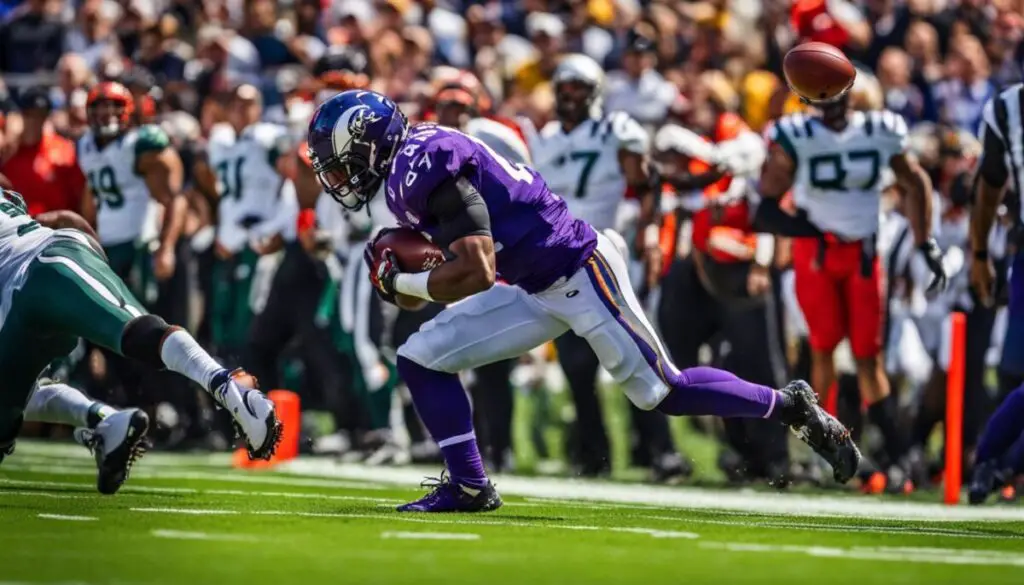
NFL Photography Equipment: Understanding Camera Body and Lens Prices
When it comes to NFL photography, investing in the right equipment is crucial for capturing the fast-paced action of the game. High-quality camera bodies and lenses can make a significant difference in image quality, durability, and performance. However, the cost of such professional-grade gear can vary greatly, depending on the specific camera body and lenses chosen.
Professional camera bodies designed for NFL photography can range from several thousand dollars to over ten thousand dollars. These higher price points reflect the advanced features, robust build quality, and cutting-edge technology required to handle the demanding environment of NFL events. The camera body serves as the foundation for capturing high-resolution images with fast autofocus and continuous shooting capabilities, ensuring photographers never miss a moment on the field.
Lenses, on the other hand, also play a critical role in NFL photography, allowing photographers to zoom in on the action and capture the intensity of the game. Telephoto lenses, which are commonly used in NFL photography to get close-up shots of players and plays, can range from $10,000 to $13,000 for professional-grade options. These lenses are engineered to provide exceptional optical performance, sharpness, and image stabilization, allowing photographers to deliver stunning shots that truly immerse viewers in the game.
When it comes to NFL photography equipment, the prices of camera bodies and lenses can reflect the advanced technology, durability, and precision required to capture the thrilling moments of professional football. While the cost may be significant, investing in high-quality gear ensures that photographers have the tools necessary to deliver exceptional images that capture the essence of the game.
Benefits and Perks for NFL Photographers
Being an NFL photographer comes with a range of benefits and perks that add value to the profession beyond just the salary. These benefits provide financial security and stability, ensuring that photographers can focus on capturing captivating images without having to worry about their well-being.
One of the key benefits for NFL photographers is health insurance. This coverage helps protect photographers from unexpected medical expenses, ensuring that they have access to the necessary medical care in case of illness or injury. Health insurance provides peace of mind and allows photographers to prioritize their health while pursuing their passion for capturing stunning images on the field.
Retirement plans are another significant perk for NFL photographers. These plans help photographers secure their financial future, allowing them to save and invest for retirement. With a retirement plan in place, photographers can build a nest egg over time, ensuring that they can enjoy their golden years comfortably and continue to pursue their creative endeavors.
In addition to health insurance and retirement plans, NFL photographers also enjoy perks like paid vacation time. This allows them to take breaks, recharge their creative batteries, and spend quality time with their loved ones. Paid vacation time is essential for maintaining a healthy work-life balance and preventing burnout, ultimately enabling photographers to deliver their best work season after season.
Overall, the benefits and perks associated with being an NFL photographer go beyond just monetary compensation. Health insurance, retirement plans, and paid vacation time provide photographers with the stability and support they need to excel in their profession, allowing them to continue capturing breathtaking images that capture the essence of the game.
The Importance of Investment in Quality Equipment
When it comes to photography, investing in quality equipment is key to achieving exceptional results. While the cost of camera gear may seem steep, the long-term value and benefits far outweigh the initial investment. Quality equipment not only produces better image quality but also offers durability, reliability, and compatibility with future advancements. It’s a wise decision for both professional photographers and hobbyists alike.
Investing in reliable equipment ensures that you can capture stunning images consistently, whether you’re shooting landscapes, portraits, or action-packed sports moments. High-quality cameras and lenses are designed to deliver optimal performance, allowing you to capture fine details, vibrant colors, and clear, sharp images. This level of image quality is essential, as it sets your work apart and leaves a lasting impression on your audience.
Moreover, investing in quality equipment saves you money in the long run. By purchasing reliable gear, you reduce the need for frequent repairs or replacements, ultimately minimizing maintenance costs. Quality equipment is built to last, with robust construction and advanced features that withstand the demands of intensive use. Whether you’re a professional photographer covering events or a hobbyist exploring your passion, having gear you can rely on is essential for a seamless and enjoyable photography experience.
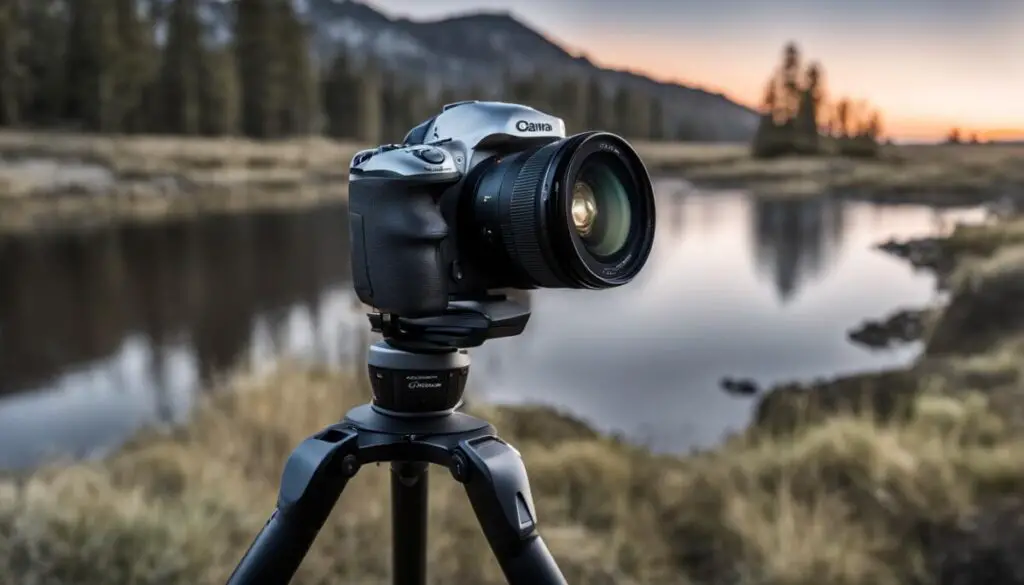
Lastly, quality equipment offers compatibility with future advancements in technology. Camera manufacturers continually introduce new features and innovations to enhance image quality and performance. By investing in high-quality gear, you position yourself for seamless integration with these advancements, ensuring that your equipment remains relevant and capable of delivering outstanding results as technology progresses.
The Photographic Journey of an NFL Photographer
Embarking on a career as an NFL photographer is an exciting and fulfilling journey that combines a passion for photography with a love for the game of football. It is a profession that offers a unique opportunity to capture the essence of the sport and create lasting images that tell powerful stories. NFL photography allows photographers to be on the sidelines, in the heart of the action, capturing the exhilaration, intensity, and emotion that unfold on the field.
The career progression of an NFL photographer typically starts with building a strong portfolio that showcases sports photography skills. This portfolio becomes the key to gaining recognition and establishing connections within the football industry. Working with media outlets or local sports teams provides invaluable experience and exposure, allowing photographers to refine their skills and expand their network.
As photographers gain experience and proficiency, they may have the opportunity to cover local games and events, gradually working their way up to covering NFL games. The path to becoming an NFL photographer requires dedication, perseverance, and a continuous desire to learn and improve. It is a journey that demands technical skill, creativity, and the ability to anticipate and capture decisive moments that define the game.
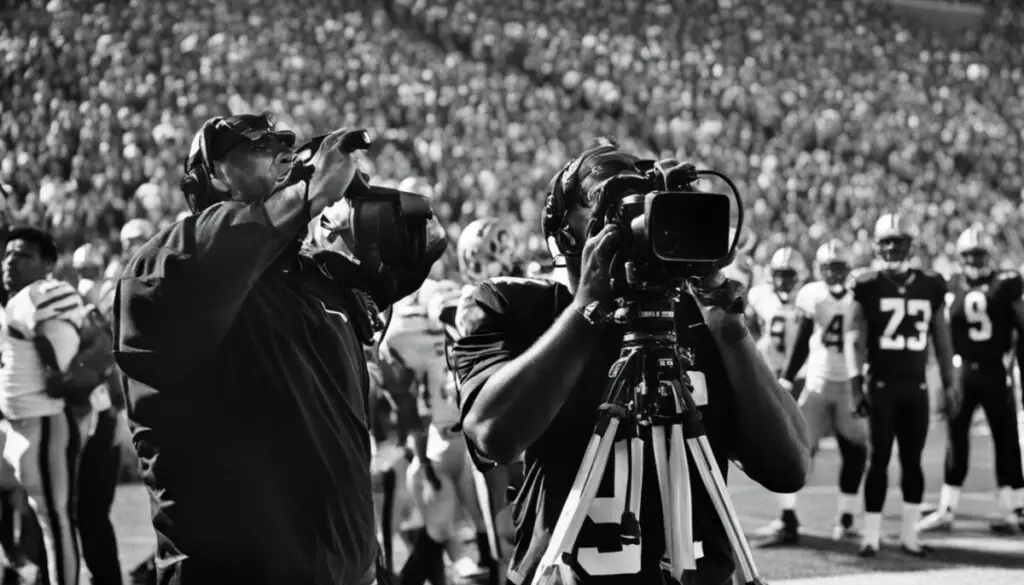
Being part of the NFL photography community provides photographers with a platform to showcase their work to a wide audience of football fans. The images captured by NFL photographers contribute to the storytelling of the sport, evoking emotions and creating a connection between the game and its viewers. Their work has the power to inspire, excite, and immortalize the unforgettable moments that unfold on the gridiron.
The Impact of NFL Photographers on the Industry
NFL photographers play a crucial role in capturing the essence of football through their exceptional image capture skills. These talented individuals have the power to freeze moments of action, emotion, and storytelling, creating a visual narrative that resonates with fans worldwide.
Through their lenses, NFL photographers document the games, highlighting the intensity, passion, and athleticism of the players. Their images convey the excitement and drama of each play, immersing viewers in the heart of the action. With careful composition and timing, they capture the defining moments that define a game, evoking a wide range of emotions from joy to despair.
Furthermore, NFL photographers contribute significantly to the overall storytelling of the sport. Their images are used by media outlets, sports publications, and online platforms to tell captivating stories, not only about the game itself but also about the players, the teams, and the fans. These visual narratives enhance the connection between the sport and its followers, deepening the audience’s engagement and passion for football.
FAQ
Why are cameras so expensive?
The high price of cameras is due to factors such as advanced technology, quality materials, and research and development efforts to improve image quality and performance.
What factors affect the cost of memory cards?
Memory card costs are influenced by factors like throughput, capability, and numeric values such as X, UHS classifications, and UDMA ratings.
Why are camera lenses expensive?
Camera lenses are costly due to precision-ground glass elements, specialized coatings, premium materials, and ongoing research and development efforts to improve optical performance.
Why is camera equipment expensive?
Camera equipment is built to be durable and reliable, capable of withstanding extreme conditions. The use of high-quality materials and weather sealing adds to the overall cost of camera equipment.
Why are Nikon lenses more expensive?
Nikon lenses command higher prices due to factors such as backward compatibility and the brand’s reputation for meticulous design and engineering.
How much do NFL photographers make?
The salary of an NFL photographer varies based on experience, reputation, and the team or organization they work for. Freelance photographers charge either a flat rate or an hourly rate.
How much does NFL photography equipment cost?
The cost of NFL photography equipment depends on the specific gear and brand. Professional-grade camera bodies and telephoto lenses can range from several thousand dollars to tens of thousands.
What are the requirements to become an NFL photographer?
To become an NFL photographer, you must possess the necessary camera equipment, build a strong portfolio in sports photography, and establish connections within the football industry.
What experience is necessary for an NFL photographer?
An NFL photographer needs a multifaceted experience in sports photography, including a deep understanding of the game, the players, and the industry.
What skills are important for NFL photography?
Succeeding as an NFL photographer requires technical skill, creativity, and the ability to think creatively and capture compelling moments on the field.
What is the average salary of an NFL photographer?
The average salary of an NFL photographer is around $75,000 per year, varying based on experience level and the team or organization they work for.
How much does NFL photography equipment cost?
NFL photography equipment, including camera bodies and lenses, can range from several thousand dollars to tens of thousands of dollars, depending on the specific gear and brand.
What benefits do NFL photographers receive?
In addition to their salaries, NFL photographers may receive benefits such as health insurance, retirement plans, and paid vacation time.
Why is investing in quality equipment important for photographers?
Quality equipment produces better image quality, offers durability and reliability, and ensures compatibility with future advancements, making it a worthwhile investment for photographers.
What is the path to becoming an NFL photographer?
The path to becoming an NFL photographer involves building a portfolio, establishing connections within the industry, and working your way up to covering NFL events.
What impact do NFL photographers have on the industry?
NFL photographers play a vital role in capturing the action, emotion, and storytelling elements of football, influencing how audiences perceive and engage with the game.

